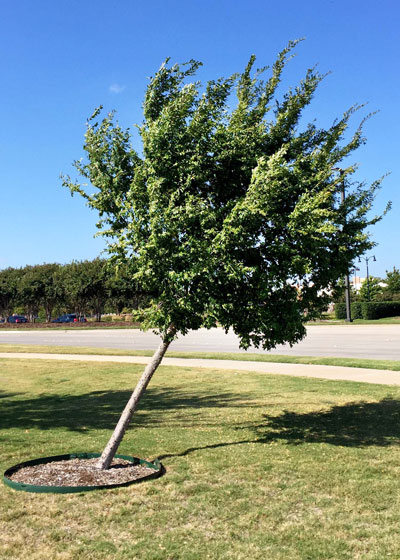Sometimes You Just Start Over
During the pandemic my wife and I ate in our car more than we cared to. I sat looking at this poor lacebark elm on several occasions and my heart just hurt for it.

What should have been done…
When you plant a new tree it’s absolutely critical that you get it bolt upright at the outset. If it’s out of plumb initially, it will always be that way.
That’s why it’s so critical that you stake it and attach guy wires to its trunk 60 to 65 percent of the way up the trunk. Those wires must be loose around the trunk, and they must be padded to prevent them from rubbing through the outer tissues. But while they’re loose around the trunk, they must be taut from the trunk to the stakes.
This tree didn’t have such good fortune, and unless some type of correction is made this coming winter (while it’s dormant), it will not be salvageable. That’s pretty obvious in the case of this tree. For many other trees the angle will be much smaller – but almost as annoying.
What will have to be done to save this tree…
Pushing or pulling a leaning tree into a vertical position may make it look better at the time, but as soon as you remove those supports, even 10 years later, it will go back to its old position. Trees have an incredible “memory” of their growth forms.
This will essentially involve digging the tree up and replanting it right back into the same hole, but with its trunk exactly vertical. Yes, there will be a loss of roots in the process, and yes, transplant shock will require that you thin out some of the top growth.
It will need to be staked and guyed just like it should have been in the first place. But if you do all of those things, this tree could be saved.
Of course, it will still be a lacebark elm, and you may have heard me mention that this species is notorious for developing “the leans.” Even mature specimens often start to tilt from prevailing southerly breezes, and by that time there isn’t much you can do about it. It’s a tree that just doesn’t support itself very well.
